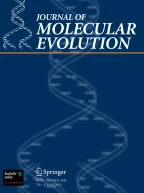- Masato Nikaido1,
- Kuniko Kawai1,
- Yin Cao2,
- Masashi Harada3,
- Satoru Tomita4,
- Norihiro Okada1 &
- …
- Masami Hasegawa2
736Accesses
121Citations
3Altmetric
Abstract.
The complete mitochondrial genomes of two microbats, the horseshoe batRhinolophus pumilus, and the Japanese pipistrellePipistrellus abramus, and that of an insectivore, the long-clawed shrewSorex unguiculatus, were sequenced and analyzed phylogenetically by a maximum likelihood method in an effort to enhance our understanding of mammalian evolution. Our analysis suggested that (1) a sister relationship exists between moles and shrews, which form an eulipotyphlan clade; (2) chiropterans have a sister-relationship with eulipotyphlans; and (3) the Eulipotyphla/Chiroptera clade is closely related to fereuungulates (Cetartiodactyla, Perissodactyla and Carnivora). Divergence times on the mammalian tree were estimated from consideration of a relaxed molecular clock, the amino acid sequences of 12 concatenated mitochondrial proteins and multiple reference criteria. Moles and shrews were estimated to have diverged approximately 48 MyrBP, and bats and eulipotyphlans to have diverged 68 MyrBP. Recent phylogenetic controversy over the polyphyly of microbats, the monophyly of rodents, and the position of hedgehogs is also examined.
This is a preview of subscription content,log in via an institution to check access.
Access this article
Subscribe and save
- Get 10 units per month
- Download Article/Chapter or eBook
- 1 Unit = 1 Article or 1 Chapter
- Cancel anytime
Buy Now
Price includes VAT (Japan)
Instant access to the full article PDF.
Similar content being viewed by others
Author information
Authors and Affiliations
Graduate School of Bioscience and Biotechnology, Tokyo Institute of Technology, Yokohama, Japan, , , , , , JP
Masato Nikaido, Kuniko Kawai & Norihiro Okada
Institute of Statistical Mathematics, Tokyo, Japan, , , , , , JP
Yin Cao & Masami Hasegawa
Osaka City University Medical School, Osaka, Japan, , , , , , JP
Masashi Harada
Gene Research Center, Tokyo Institute of Technology, Yokohama, Japan, , , , , , JP
Satoru Tomita
- Masato Nikaido
You can also search for this author inPubMed Google Scholar
- Kuniko Kawai
You can also search for this author inPubMed Google Scholar
- Yin Cao
You can also search for this author inPubMed Google Scholar
- Masashi Harada
You can also search for this author inPubMed Google Scholar
- Satoru Tomita
You can also search for this author inPubMed Google Scholar
- Norihiro Okada
You can also search for this author inPubMed Google Scholar
- Masami Hasegawa
You can also search for this author inPubMed Google Scholar
Additional information
Received: 21 December 2000 / Accepted: 16 February 2001
Rights and permissions
About this article
Cite this article
Nikaido, M., Kawai, K., Cao, Y.et al. Maximum Likelihood Analysis of the Complete Mitochondrial Genomes of Eutherians and a Reevaluation of the Phylogeny of Bats and Insectivores.J Mol Evol53, 508–516 (2001). https://doi.org/10.1007/s002390010241
Issue Date:



